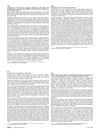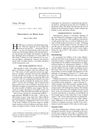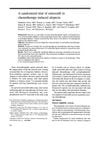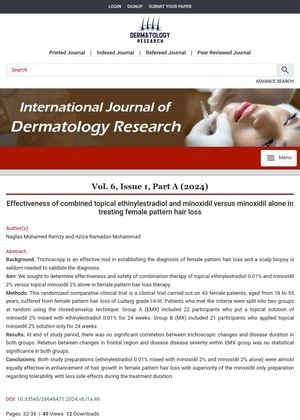TLDR Minoxidil alone is as effective as the combination but has fewer side effects.
This study investigated the effectiveness and safety of a combination therapy of topical ethinylestradiol 0.01% and minoxidil 2% compared to minoxidil 2% alone in treating female pattern hair loss. Conducted on 43 female patients aged 18 to 55 with Ludwig grade I-II-III hair loss, the trial divided participants into two groups: one using the combination therapy and the other using only minoxidil. After 24 weeks, both treatments were found to be almost equally effective in promoting hair growth. However, the minoxidil-only treatment was superior in terms of tolerability, with fewer side effects reported.
 February 2024 in “Cosmoderma”
February 2024 in “Cosmoderma” Low-dose oral minoxidil can help treat male and female pattern hair loss, especially in those who can't use topical treatments or have heart health issues.
February 2020 in “The Pharmaceutical Society of Japan” 8 citations
,
October 2015 in “PubMed” 5% minoxidil foam effectively treats female hair loss.
 May 2015 in “Journal of The American Academy of Dermatology”
May 2015 in “Journal of The American Academy of Dermatology” 5% minoxidil foam helps women with thinning hair.
January 2007 in “Strait Pharmaceutical Journal” Water-soluble minoxidil effectively promoted hair growth in mice.
 1 citations
,
September 2002 in “PubMed”
1 citations
,
September 2002 in “PubMed” Minoxidil helps stimulate hair growth and reduce hair loss in women with androgenic alopecia.
 370 citations
,
September 1999 in “The New England Journal of Medicine”
370 citations
,
September 1999 in “The New England Journal of Medicine” Finasteride and minoxidil are effective for hair loss, but continued research is needed for better treatments.
 127 citations
,
July 1996 in “Journal of The American Academy of Dermatology”
127 citations
,
July 1996 in “Journal of The American Academy of Dermatology” Minoxidil shortens baldness from chemotherapy by 50.2 days without significant side effects.
36 citations
,
January 1991 in “PubMed” 2% Minoxidil does not prevent hair loss during chemotherapy.





